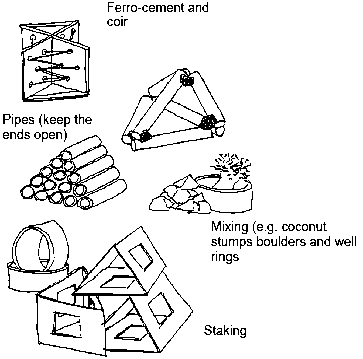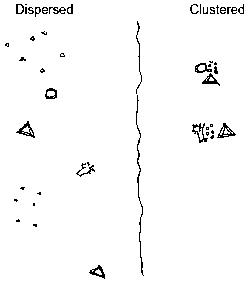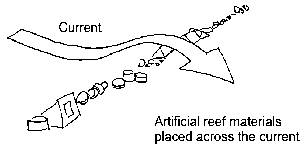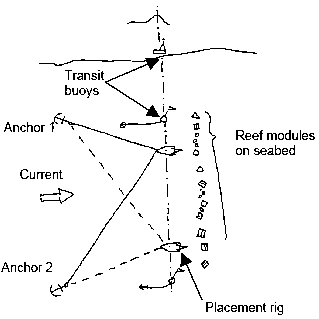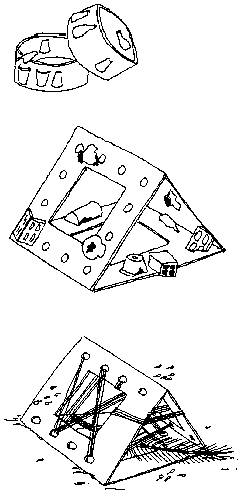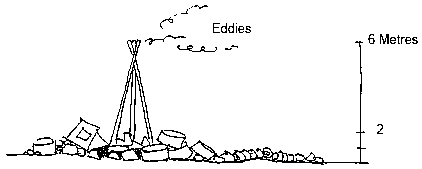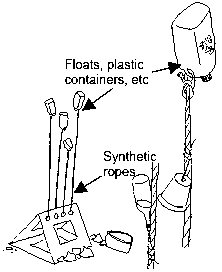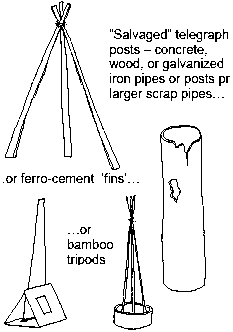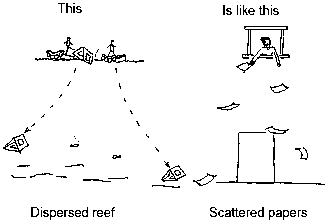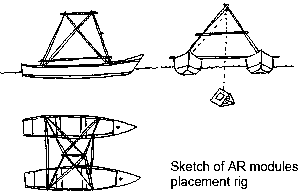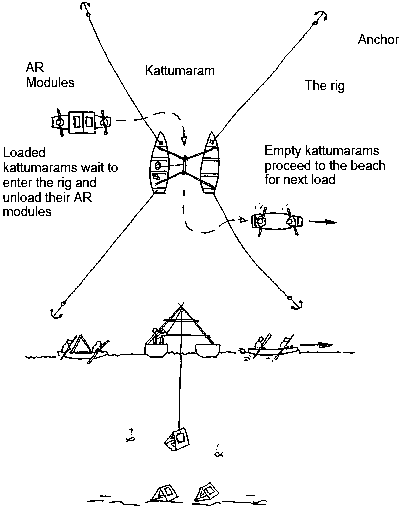How to Build an Artificial Reef
Contents
Technical Brief
People are destroying coral reefs and other important fish habitats at an unprecedented rate. Destructive fishing practices and pollution are the two main causes. While many NGOs are very actively trying to convince the world's politicians to take action to prevent harmful practices, practical actions are also being undertaken by many local communities.
As coral reefs are destroyed the communities living in the coastal area suffer first from depletion of fish stocks. The shorelines, where their houses and businesses are and where boats are moored, also suffer, as they are no longer protected from the sea by the reef. Once a community has felt the effects of the loss of the reef, they may decide to take action.
One part of a solution could be for the community to build artificial reefs. It takes many, many years for the coral that makes up the structure of a reef to grow. Artificial reefs (ARs) have a long tradition in many parts of the world. In recent years, however, the use of modern materials has greatly increased their potential. For example the use of purpose-built building blocks called modules, constructed from cement, plastics, and steel, has enabled the construction of relatively large structures using simple techniques (see examples below).
Their use has advantages and disadvantages. They can be very valuable in repairing damaged reefs and re-establishing reefs that have been destroyed, but only if the reefs are to be used as nurseries or Eco-sanctuaries, or if they are to be fished using traditional methods. If entirely new reefs are being created in areas that are already overfished, they may exacerbate the problem by drawing fish to the new reef, where they are more easily caught. Reefs should also be built with materials that will not contaminate the area if they are disturbed or break down: synthetic materials and plastics release chemicals under the combined action of UV light of the sun and salt water; for example tyres should not be used.
Best are stones, cleaned and unpainted iron, wood...
For the artificial reefs to contribute to sustainable fisheries in the longer term, it is important that the fishing communities are involved in all steps of the decision-making and development processes. They should participate in the selection of the reefs-sites, the choice of materials, the management and monitoring of the reefs, and in their evaluation. It must be the community's decision to proceed (or not) at each stage of the process.
After the community has agreed to go ahead, there are two main phases to creating the artificial reef: construction, and placement.
Construction
Variety
It is important when constructing the reef to provide as much diversity of habitat as possible, as this encourages the greatest diversity of species. The greater the biodiversity living on the reef, the healthier the reef will be. Use many different types of modules, including well rings, ferrocement modules, tyres, granite boulders, coconut stumps, poles, pipes, bottles, and whatever else is available locally. Use them in a variety of combinations and orientations.
Clusters
It is important to cluster plenty of material together densely; the more the better. Very dispersed materials will not be colonised successfully, and will only be wasted. (See later for a suggested technique for placement.)
Orientation of the clusters is also important. Line structures or clusters should be placed so that they are across the current. This provides a sheltered environment for smaller fishes, and a "standing wave" above the reef, which throws up food for a variety of species. Before you begin placing the reef material set two marker buoys in the water and a land transit to give you an approximate line to follow.
Crevices
Ensure that the reef that you are creating has plenty of holes and crevices to provide refuge and shelter from predators and current. The greater the variety of size, density, and orientation of the crevices the better, as they will shelter a wider variety of creatures. Crevices can be created in a number of ways, usually by leaving holes in fabricated modules or attaching materials such as broken pipes to the modules to create holes. Whole or broken pantiles, bottles, cooking pots, buckets, flower pots, and bricks are just some of the many items that can be "glued" onto modules to create interesting crevices. It is also important to attach natural or synthetic fibres to the reef modules. They make a very attractive substrate for the smallest of creatures, and are ideal places for cuttlefish to lay their eggs.
Height
It is recommended that reefs should be about one-third of the water depth. If that is not possible, then you should at least introduce a number of taller modules into the reef. Height makes it easier for roving predatory fish to locate the reef, thereby increasing further the biodiversity of the reef. The reef will act like a beacon, and in times of sediment disturbances the highest objects may still show above the sediment cloud or project eddies and disturbances further afield.
Height can be achieved in a number of ways, for example by using salvaged telegraph posts or pipes, or poles made from concrete, wood, or galvanised iron. You could also make ferrocement "fins" or bamboo or wooden tripods. If none of those materials are available you can create height cheaply using air too.
Floats or plastic containers full of air or other buoyant items can be tied with rope to modules. Other small items can be tied along the length of the rope to provide crevices and surfaces on which biomass can begin to accumulate and grow.
Placement
The placement of the modules that will make up the reef is extremely important. In most communities only small boats will be available from which to launch the modules, and experience has shown that although the modules seem heavy on land, if they are simply tipped off the deck they can drift quite far as they fall through the water column. This will result in widely dispersed modules and a very ineffective reef. (This may be likened to dropping individual sheets of paper from a third floor window; one would clearly not expect them all to land in the same place!) As mentioned earlier, only a concentrated collection of modules will result in a rich and extensive marine environment.
Site selection
The most reliable way to select a site for an artificial reef is to rely on the experience and knowledge of the local fishermen. They will have a detailed mental map of the depth of the water and the structure and form of the seabed, and they will know where reefs used to exist if they have been destroyed.
To enable the community to have control over the creation of the reef, the following placement method has been designed to use artisanal fishing craft and local skills and materials, and to be operable by the community themselves. Once the community has mastered the placement method they can repair or enlarge the reef themselves, or create new reefs as they see fit.
As this method evolved in South India, it uses the plywood canoes that are the most popular artisanal craft there. The method can be adapted to suit local craft. A rig comprising two plywood canoes is rafted together, and a quadrapod arrangement is assembled across them (see sketches). A rope-and-pulley system is then mounted on the quadrapod; it must be strong enough (and the rope long enough) to lift the modules off the boats (in this case kattumarams) which have ferried the modules out to the rig, and lower them onto the seabed. The site for the reef is chosen by the community, and is marked out to ensure that it is oriented across the current.
The rig is anchored over the proposed site using four anchors. The use of four anchors permits fairly precise positioning of the rig, and also allows controlled movements to be made away from the centre of the site. The modules are lifted off the kattumarams one at a time and lowered, positioning clusters of modules on and around the centre of the site.
Further information
- Artificial Fish Habitats: A community programme for biodiversity conservation, John Fernandez. Programme for Community Organisation, Kerala, India, 1994.
- Symposium on Artificial Reefs and Fish Aggregating Devices as Resource Enhancement and Fisheries Management Tools, 14-17 May 1994, Colombo, Sri Lanka. Papers from the Information Department, FAO, via della Terme di Caracalla, Rome, Italy.
- Artificial Reefs for Marine Habitat Enhancement in South-east Asia, A.T. White et al, ICLARM, 1994. ICLARM have a great deal of experience and numerous other publications about artificial reefs. ICLARM, PO Box 2631, 0718 Makati, Metro Manila, Philippines.
Artificial Reefs for Submerged and Subaerial Habitat Protection, Mitigation and Restoration LEE E. HARRIS & MARSHA PARDEE WOODRING
http://www.artificialreefs.org/ScientificReports/LeeHarrissumbergedhabitatcreation.htm
References and further reading
This Howtopedia entry was derived from the Practical Action Technical Brief Energy from the Wind.
To look at the original document follow this link: http://www.practicalaction.org/?id=technical_briefs_water
Related articles
Useful addresses
Practical Action
The Schumacher Centre for Technology & Development, Bourton on Dunsmore, RUGBY, CV23 9QZ, United Kingdom.
Tel.: +44 (0) 1926 634400, Fax: +44 (0) 1926 634401
e-mail: practicalaction@practicalaction.org.uk
web: www.practicalaction.org

Global Coral Reef Alliance (GCRA)
Dr. Thomas J. Goreau President
37 Pleasant Street, Cambridge, Massachusetts 02139, USA
Telephone: 617-864-4226, 617-864-0433
E-mail: goreau@bestweb.net
Web site: http://www.globalcoral.org
http://www.reefball.org/index.html
Todd Barber, Chairman
3305 Edwards Ct
Greenville, NC 27858 USA
941-720-7549 (Cell)
252-353-9094 (Direct)
reefball@hotmail.com
reefball@reefball.com
Related articles
- How to Build an Artificial Reef
- Gene Pool Protected Fishing
Support the work of howtopedia, help us to continue to write and translate more practical articles on simple technologies!
<paypal />
